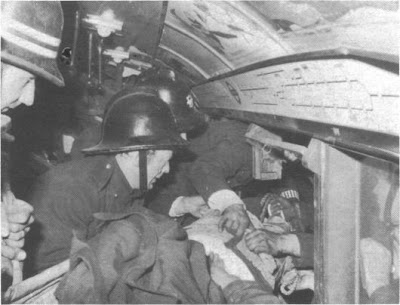

 Photos: British Medical Journal and BBC
Photos: British Medical Journal and BBC
On Feb. 28, 1975, more than 40 people died when a train - arriving at the Moorgate Underground station from Drayton Park - overshot the platform and crashed into a dead-end tunnel during the morning rush hour. The last survivor wasn't freed from the carnage of ``the 8:37'' until evening.
``If there's a hell, I've lived to see it,'' a doctor was quoted as saying.
On the 25th anniversary of the wreck, Peter Woodman of the Press Association wrote that the rescue and recovery went on for six days, with more than 1,300 firefighters, 240 police officers, 80 ambulance attendants and 16 physicians ``on the spot'' - along with hospital staff and volunteer services.
The six-car train was built in 1938, and operated a two-and-a-half mile shuttle from Drayton Park, calling at Highbury and Essex Road stations, Woodman wrote. It slammed into the 5 foot thick wall at speed - roughly 35-40 mph.
Rescuers spoke of the ``raw courage'' of Policewoman Margaret Liles, 19, a passenger in the first carriage, who was freed after more than 12 hours - after doctors amputated one of her feet.
Conditions in the tunnel tested the emergency services. "The air is so bad that the doctors have decreed that everybody working down there must wear breathing masks," said a police spokesman, quoted by the Yorkshire Post.
Among the dead was train driver Leslie Newson, 55.
Known as careful and conscientious, Newson ``had been in good health and had not taken any alcohol or drugs, and was considered an unlikely suicide candidate,'' the BBC said.
The cause of the Moorgate disaster remains a mystery. ``Nothing was wrong with the train, the signalling equipment or the track, '' according to the BBC, though London Underground introduced new safety measures after the wreck.
____
British Medical Journal - June 3, 2000
Railway signals passed at danger: psychology matters
Glin Bennet, formerly senior lecturer and consultant psychiatrist
Bristol
Seventy five per cent, eighty per cent. Over the years this is the seemingly unvarying proportion of transport accidents ascribed to human factors. Investigations are meticulous, the engineers take care to see that every nut and bolt is studied, yet so often the conclusion is the same: “human failure.”
This seems to be accepted as an explanation, and with it the matter can be closed. For any psychiatrist, reports of odd behaviour, such as driving a car or a train through a red light, are merely the beginning of an investigation, a warning that there may be problems below the surface.
In the aftermath of the Paddington rail disaster in October 1999, attention has been focused on signalling systems, and rightly so. The assumption seems to be that if the signals and points can all be made reliable then accidents should cease. But that does not explain the 600 or so signals passed at danger each year in the United Kingdom.
There is nothing new in all this, as Professor R A Cocks has pointed out (BMJ 1999;319:1018-9). In the 1940s and 1950s the late Professor Derek Russell Davis published research on the human factors which lead to accidents. His researches into rail incidents, usually signals passed at danger, were made with the full cooperation of British Rail, and in private interviews drivers spoke openly to him about their behaviour in the accidents, their anxieties, and distracting worries.
In my own studies of small boat sailors, airline pilots, train drivers, and motorists, numerous examples emerged of psychological processes which can lead to accidents. For example, seeing the signal that you want to see, in the colour that you want, not what is actually there (Lewisham train disaster, 1957—90 dead; Norton Fitzwarren, 1940—27 dead; perhaps also Harrow and Wealdstone, 1952—112 dead). Sailors can misread lights in the same way.
Preoccupation with matters remote from the scene may account for some of the 600. At the Hayward's Heath accident in 1973 the driver misread the signals and drove his loopline train on to the main line and it was struck from behind by an express. This driver was reported as going through a divorce at the time, had financial worries, and a stomach ulcer. In November 1981 the driver of a commuter train was involved in a collision from misreading the signals. He was evidently dosing himself with pain killing drugs for an aching wisdom tooth, his wife had just given birth to their first child, and his mother was suffering from cancer.
The Moorgate underground train disaster in 1975, 43 killed, was never satisfactorily explained, or possibly was never satisfactorily investigated. The medical experts involved gave speculative diagnoses that the driver (who was killed) was suffering from “akinesis with mutism” or “transient global amnesia.” I know nothing of these as acute conditions, but I would have wanted to inquire more into the unfortunate driver's circumstances.
The reports of inquiries that I have read tended to be chaired by military men, with a robust approach to mechanical detail and not much interest in psychological processes. There is also the subtle British resistance to looking into the psychological process of others, because of the unspoken acknowledgment from so doing that you might have a vulnerable psyche yourself, and that would not do. Fortunately, the drivers of most rail incidents survive, unlike their colleagues in the air, and so there is a real opportunity to learn about the causes of the 75% or 80% of transport accidents. In fact the railways are excellent laboratories for such studies, and they have a relevance to all modes of transport.
Improvements in signalling and track are important, of course, but the drivers are also important. These people can confound safety devices when they fall victim to adverse psychological processes, and if we are not going to opt for driverless trains we need to understand more about the drivers.